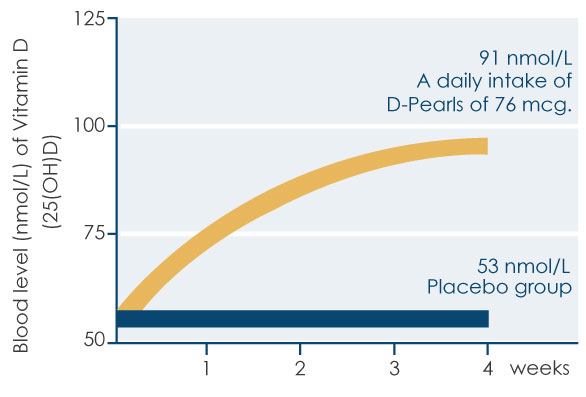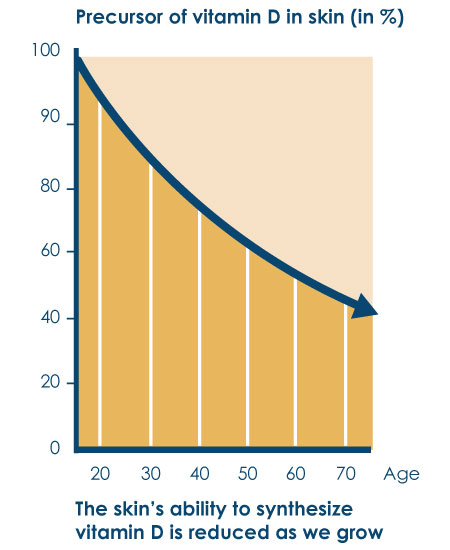Bio-Vitamin D3 (D-Pearls)
Buy online in one of our webshops listed below:
| 1 capsule contains | % RDA* | ||
|---|---|---|---|
| Vitamin D3 (cholecalciferol) | 125 µg | 2500% |
*RDA= Recommended Daily Allowance
Products Facts
Directions
1 capsule per day or as directed by a health professional. Preferably with a meal.
Do not exceed the recommended amount.
Pregnant and lactating women and those on medication should seek professional advice prior to taking supplements.
Dietary supplements should not be used as a substitute for a varied diet or healthy lifestyle.
Ingredients
Bulking agent: Olive oil
Capsule shell: Bovine gelatin
Humectant: Glycerol, purified water
Vitamin D3 (Cholecalciferol)
Colour: Iron oxide
Storage
Store at room temperature.
Keep out of reach of children.
What is Bio-Vitamin D3, 125 µg?
Bio-Vitamin D3 (D-Pearls) are small, soft gelatin capsules with 5,000 IU (125 µg) of vitamin D3 in each capsule. The product is designed for invididuals with an increased need for vitamin D. Vitamin D is lipid-soluble so the vitamin D content in D-Pearls is dissolved in cold-pressed olive oil for improved absorption in the digestive system. Due to their small size, the capsules are easy to swallow, and they can even be chewed. According to published research, D-Pearls has good absorption in the body.
Safety and quality
Pharma Nord's factory in Vojens, Denmark, manufactures both pharmaceutical drugs and dietary supplements. The company has chosen to manufacture all its products in compliance with pharmaceutical guidelines and rules for quality inspection. That way, consumers will always know that any Pharma Nord product meets the highest standards for quality, effect, and safety.
Minor variations may occur in the firmness of the vitamin D capsules due to fluctuations in temperature and humidity. Product tests carried out in our climate chambers show that this does not in any way affect the quality or the effect of the preparation.
D-Pearls has been on the European market since 2007.
Documented bioavailability
Pharma Nord's preparation (D-Pearls) has been tested by researchers at the University of Oslo. In their study, they supplemented athletes with different doses of vitamin D or matching placebo. The study showed excellent absorption of vitamin D from a low- and high-dosed version of D-Pearls. However, the athletes that took the placebo capsules had unchanged vitamin D levels in their blood.

The illustration shows the difference in vitamin D blood levels over a 4-week period in the group receiving 76 mcg (3,040 IU) of vitamin D daily and in the group receiving placebo capsules.
Source: Baumann ACK. Effekt av vitamin D-tilskudd på 25(OH)D status. University of Oslo, July 2013.
What is vitamin D?
Vitamin D is a lipid-soluble vitamin and needs to be ingested with some kind of dietary fat in order for the intestine to be able to absorb it. Like most other vitamins, vitamin D is essential. There are several kinds of vitamin D, but the two most important forms are D2 (ergocalciferol) and D3 (cholecalciferol).
Vitamin D2 Is only available from the diet. It is produced by certain fungi and plants when they are exposed to ultraviolet light.
Science used to believe that both forms of vitamin D were equally effective in the body. However, depending on what method is used to measure their effectiveness, vitamin D3 is 56-87 per cent more effective than vitamin D2 in terms of raising blood levels of vitamin D. Moreover, D3 is stored in fat tissue more than three times as effectively as D2.*
* Heaney RP, et al. Vitamin D3 Is More Potent Than Vitamin D2 in Humans. J Clin Endocrinol Metab 2010.
Children and nursing home residents have an increased need for vitamin D
Vitamin D has an array of important functions in the body. For example, vitamin D:
- Is important for normal cell division
- Helps to maintain normal bones and teeth
- Contributes to a normal absorption and utilization of calcium and phosphorus
- Plays a role in the body's immune system and muscle function
 Sources of vitamin D
Sources of vitamin D
There are two primary sources of vitamin D: Sunlight and Diet.
Vitamin D from the sun
On the surface of our skin we have a cholesterol precursor that is converted into vitamin D when exposed to UV-rays form sunlight. Once it has been exposed to sunlight it is reabsorbed in the body and converted (hydroxylated) in a two-step process, first in the liver and then in the kidneys and in other tissues. Once these two steps are completed, vitamin D has become active.
Sunlight is our main source of vitamin D but the synthesis is only possible when the sun sits sufficiently high in the sky. In large parts of Europe, this is limited to the period from April through September.
Rule of the thumb
To form vitamin D from sunlight, the UV index must be at least 3 or higher. The UV index is used to measure the intensity of the sun's ultraviolet radiation. If you are in doubt about whether you can make vitamin D from the sun, simply look at your shadow to determine the sun's position in the sky. If your shadow on a horizontal surface in the sun is equal in length to your height, then the altitude of the sun above the horizon is 45 degrees. This position enables vitamin D synthesis.
Vitamin D from the diet
It is difficult to get a sufficient amount of vitamin D from the diet alone, partly because one of best sources of the nutrient is oily fish such as salmon, herring, and mackerel, and people generally do not eat all that much fish. Vitamin D is also found in limited amounts in meat, milk, and eggs. In the plant kingdom, vitamin D is available in small amounts in certain fungi. The best dietary sources of vitamin D are:
|
|
|
Cooking, baking, and frying result in a certain loss of vitamin D from foods.
The need for vitamin D
 Strong vitamin-D supplements might be particularly indicated in:
Strong vitamin-D supplements might be particularly indicated in:
- Individuals with dark pigmentation as they require 5 to 10 times more exposure to sunlight to generate same amounts of vitamin D3 as individuals with little or no pigmentation
- Anyone who, regardless of their age, are at increased risk for osteoporosis
- People who do not spend time outdoors in the daytime or generally avoid sunlight
- Adults who wear fully covering clothes in the summer time
- Nursing home residents
- People older than 70 years. An older skin is less able to generate vitamin D3 from sunlight
Vegans and vegetarians are advised to adhere to the official guidelines for sun exposure and possibly take a supplement of vitamin D during the winter period.
Blood levels of vitamin D can be determined by a blood test that measures the unit 25-hydroxyvitamin D (25-(OH)D) and is expressed in nmol/L. Vitamin D status is graduated in the following way:
> = greater than
< = less than
Vitamin D Conversion
- 1 nmol/L = 0,4 ng/ml ~ 0,4 µg/L
- 75 µg = 3000 IU (international units)
Measurement of vitamin D
The safest way to know one's vitamin D status is by means of a blood test. However, for normal, healthy individuals there is no immediate need to measure blood levels of vitamin D. For certain groups, however, it is advisable to gauge their vitamin D status.
For instance, people with a lifestyle that gives reason to believe that they could benefit from checking their status. Besides the obvious factors that limit vitamin D such as lack of sunlight and poor diet, there are more subtle causes such as the fact that some types of medicine may affect the body’s vitamin D absorption, thereby increasing the need for this particular nutrient.
Vitamin D and the normal aging process
Aging affects us differently, depending on our genes and lifestyle. Still, everyone finds that, over time, the body becomes worn out and functions less efficiently. This phenomenon is part of the normal aging process and can also have an effect on our need for vitamin D.
Most of the body's cells have vitamin D receptors (VDR) which are small structures on the cells’ surface that are activated by active vitamin D3. The presence of these receptors in literally all our different tissues explains the universal need for vitamin D in our entire body.
-
The immune system

It became clear that vitamin D contributes to the normal functioning of the immune system when it was discovered that various white blood cells such as macrophages and dendritic cells as well as T and B lymphocytes are equipped with vitamin D receptors. Vitamin D enables these immune cells to carry out their different functions. For example, it has been shown that vitamin D activates genes in the cell nucleus. These genes encode peptides that inhibit viruses, bacteria, and fungi.
Our immune system reaches its peak efficiency in the teenage years. Even in healthy, elderly people, the immune system is more vulnerable to new infections that it has never encountered earlier. Elderly people produce fewer white blood cells, and the level of inflammation in their body is higher than what you see in younger people. Older people must be sure to get enough vitamin D.
-
Bone tissue

Our bone mass reaches its peak strength when we are in our 20s and 30s. From that point onward, our bone tissue gradually loses its strength due to demineralization. Vitamin D is necessary for maintaining normal bones and teeth because the nutrient helps us maintain normal calcium levels in bone tissue and in the blood.
From the age of 40, our bonen mass gradually starts to deteriorate. The loss amounts to 0.5% annually for men, whereas women lose twice that amount due to hormone changes.
-
Muscle function

Our muscles also need vitamin D to function normally. The ability of muscles to contract is dependent on calcium ions. As previously mentioned, vitamin D regulates levels of calcium in the blood and in this is important for muscle function.
As we get older, the number of vitamin D receptors in muscle tissue decreases. This results in a gradual loss of muscle mass and muscle strength. The heart muscle, on the other hand, is not significantly affected by this.
-
Skin and mucous membranes

It is known that the body produces a precursor of vitamin D in the skin when exposed to sunlight of a certain intensity. Factors that can prevent or reduce this vitamin D synthesis include severe air pollution, too much clothing, dark skin, overuse of sunscreen, obesity, the sun sitting too low in the sky, and old age.
With increasing age, the amount of collagen and elastin decreases, causing the skin to lose elasticity and strength and become more wrinkled. The skin becomes less efficient at producing vitamin D from sunlight, and the digestive tract becomes less efficient at absorbing vitamin D.
Variations in gelatin hardness
The hardness of our soft gelatin capsules can vary. The difference depends solely on the water content of the capsule shell. We dry all our soft capsules before packaging, which makes the capsules firmer and facilitates the packaging process itself. Over time, the capsules can absorb water from the air, and this will soften the capsule shell.
The variations in the hardness of the capsule have no effect on the product quality, but if a hard capsule is a problem, a solution may be to leave the capsule outside the blister sheet for a day, whereby the capsule can absorb a little water from the air. This is generally not something we recommend, as the product will no longer be protected as when it is in the blister sheet. Another method of quickly softening the gelatin capsule is to place it in lukewarm water for one minute. However, it should be seen as an emergency solution.
Official claims
The European Food Safety Authority (EFSA) has evaluated the evidence behind vitamin D and has acknowledged the following claims:
- Contributes to normal absorption/utilization of calcium and phosphorus
- Contributes to normal blood calcium levels
- Contributes to the maintenance of normal bones
- Contributes to the maintenance of normal muscle function
- Contributes to the maintenance of normal teeth
- Contributes to normal function of the immune system
- Has a role in the cell division process
- For men and women aged 60 years and older: Vitamin D helps to reduce the risk of falling as a result of postural instability and muscle weakness. Falling increases the risk of bone fractures in men and woman 60 years of age and older. (Art 14a)
Related Products
 Bio-Magnesium: Magnesium and vitamin D are biologically active in some of the same tissues, yet the two ingredients cannot replace each other. For example, both nutrients contribute to the maintenance of normal bones and teeth and normal muscle function. Also, they both play a role in cell division.
Bio-Magnesium: Magnesium and vitamin D are biologically active in some of the same tissues, yet the two ingredients cannot replace each other. For example, both nutrients contribute to the maintenance of normal bones and teeth and normal muscle function. Also, they both play a role in cell division.

